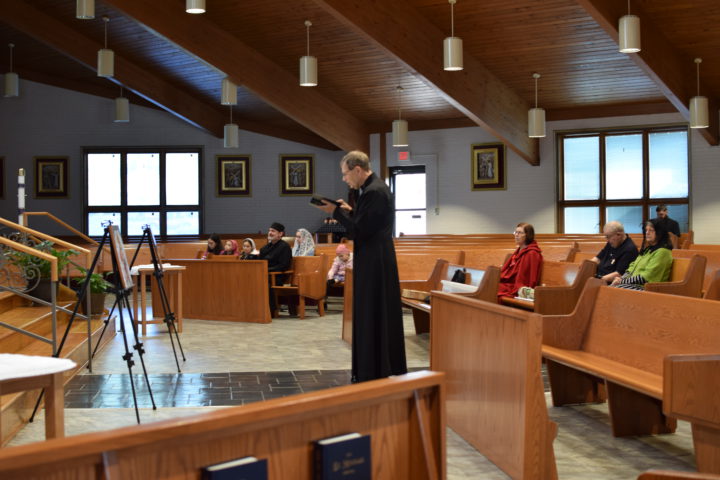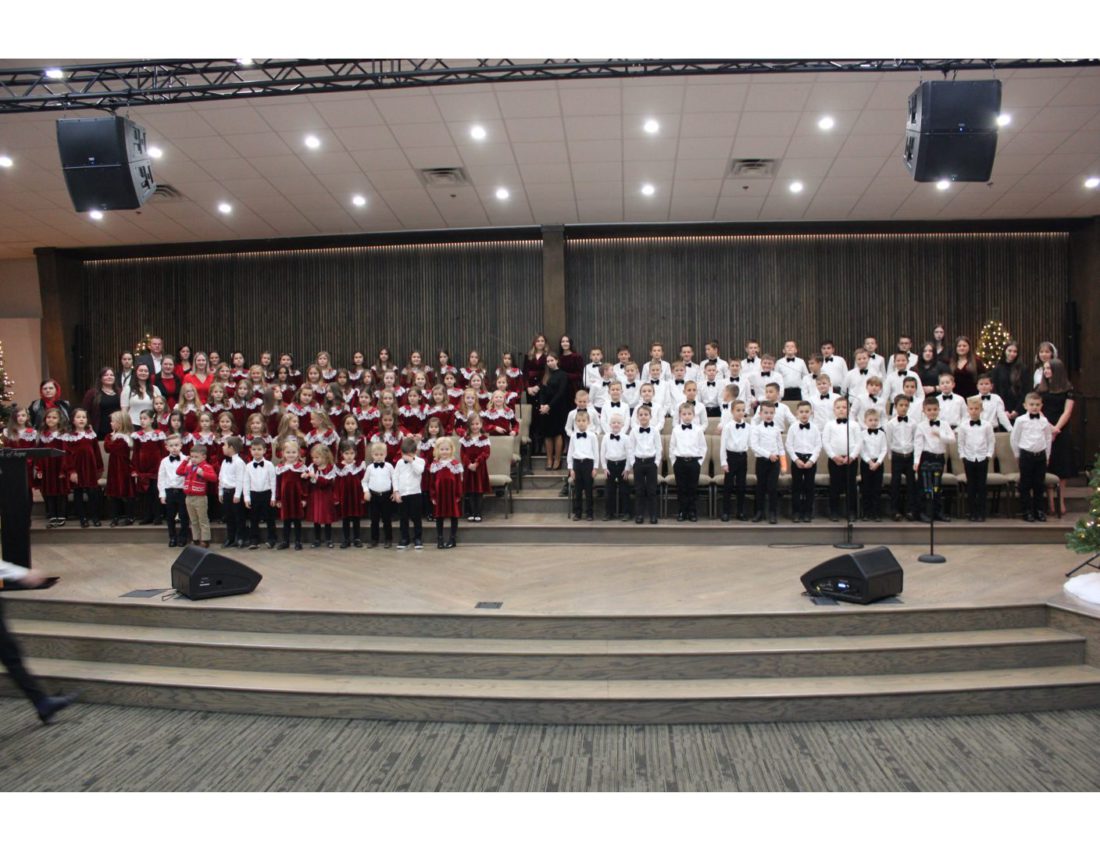This Christmas season, the Rev. Mikhail Tikhonov of the Christian Church of Hope in Emma says he’s been inspired by the 50 Ukrainian refugee families who’ve joined his congregation during the past year after fleeing the war.
“The basic meaning of Christmas is that Christ came to bring hope for humanity,” he tells Xpress. “So that is what we’re grounded in this year.”
Tikhonov estimates that 70% of the church’s 800 parishioners are Ukrainian or of Ukrainian heritage, though the congregation also includes other Slavic nationalities such as Russians, Belarusians and Moldovans. Overall, he says, the Pentecostal church’s Christmas services are very similar to those of other evangelical congregations, especially the Baptist and Assemblies of God denominations. What he does consider different, however, is the prominence of two traditions: caroling and feasting.
“Slavic people, whether it’s Thanksgiving, Easter or Christmas, they prepare big dinners,” Tikhonov says. “There is no television on: We just share life. We laugh, we cry, we sing carols together. It’s like what America used to be 30, 40, 50 years past.”
A Holy Supper feast also figures prominently in the practices of the Ukrainian Catholic Church. Locally, that tradition is represented by the Holy Apostle and Evangelist Luke Ukrainian Catholic Mission, led by the Rev. Kevin Bezner at St. Barnabas Catholic Church in Arden. Born a Roman Catholic, Bezner has a special appreciation for these traditions because they connect him to his own Ukrainian heritage, which he wasn’t even aware of until after he converted in 2007.
“Under church law, I should have been Ukrainian Catholic all along,” he says.
Songs of joy
According to the Internet Encyclopedia of Ukraine, caroling is a tradition that reaches back to pre-Christian times. There are two types of carols: koliadky, sung at Christmas, and shchedrivky, which celebrate the new year. The well-known “Carol of the Bells” is, in fact, Ukrainian composer Mykola Leontovych’s adaptation of “Shchedryk,” a traditional Ukrainian New Year’s song.
Carols are a central part of the Christmas celebrations at the Christian Church of Hope, whether they’re being sung in church by one of the many choirs or by parishioners going house to house.
“On Christmas Day at 5 o’clock in the evening, they go carol at the homes of senior citizens in our church who live by themselves,” Tikhonov explains. It’s often a group of younger people, including members of the teen and young adult choirs. “They take the accordion and guitar, they wear the Christmas hats, and they just go walk the apartment complex and sing carols.”
Classic carols also feature in the church’s Christmas programs. They include the Ukrainian song “Nebo i Zemlia” (which translates as “Heaven and Earth”) as well as English carols such as “Oh Come, All Ye Faithful.”

Vasiliy Draka, a member of the Slavic Revival Fellowship Church off New Leicester Highway, also sees the caroling tradition as the most notable difference between the holiday services at these churches and those at other evangelical houses of worship. When he was a youth leader in the early 2000s, Draka recalls, he would compile a list of folks who wanted carolers to come to their house.
And though caroling has ancient roots in Ukraine, the freedom to sing Christmas songs has a more recent meaning for some older parishioners of both the Christian Church of Hope and the Slavic Revival Fellowship who experienced religious oppression during Soviet domination. In those days, adults could have jobs taken away and children could receive bad grades simply because of their beliefs, says Draka.
Tikhonov tells a similar story. “We have a couple older men who were persecuted for their religious beliefs. They got businesses snatched from them, houses raided. Always arrested and fined for gathering. People who have not experienced the other side don’t know what we have here, the religious freedom to gather, worship, pray and seek God,” he points out, adding, “It’s a huge blessing.”
But just as important as the carols, stresses Tikhonov, are the feasts. During the holiday season, multiple families will come together for large dinners that often last up to five hours. Those gatherings will have special significance for the congregation’s refugee families, many of whom are experiencing their first Christmas away from home, notes Tikhonov.
“A lot of families are financially struggling,” he notes, adding that he’s hoping to find sponsors both within and beyond his congregation to help these people have an abundant and joyful Christmas by providing gifts for children. Potential sponsors can email the church at info@christianchurchofhope.org.
Holy fast, holy feast
According to the College of the Holy Cross’ Catholics and Cultures initiative, the Catholic Church actually consists of 24 separate denominations. The Roman Catholic Church represents 98% of all Catholic believers, but there are also 23 different Eastern Catholic churches, including the Ukrainian Catholic Church.
“For those who are familiar with the Greek Orthodox Church or the Russian Orthodox Church, we’re very similar to both,” says Bezner. “To learn about our church and who we are and what we’re about, it’s the liturgy that’s most important.”
“Liturgy opens us up to the graces God provides,” parishioner Mary Ann (who asked that only her first name and that of her husband, Dave, be used) told Xpress via email. “We feel His presence and it makes us feel closer to Him.”
Bezner performs the Divine Liturgy, the celebration of the Eucharist known as Mass in the West, at St. Barnabas every Sunday. Usually, he recites the fifth century liturgy of St. John Chrysostom. The slightly longer fourth century liturgy of St. Basil is used on special days such as Nativity Eve — what Ukrainian Catholics call Christmas Eve.
The celebration of the Nativity, however, gears up much earlier. It starts with the fast of St. Philip that begins on Nov. 15. Bezner describes it as less intense than the Lenten fast, during which most participants avoid meat and dairy products, and sometimes other foods, for 40 days leading up to Easter.
The fasting during the run-up to Nativity Eve makes the Holy Supper particularly special. “It’s an evening of bounty and hope: The Christ child is about to be born. So there’s great celebration,” says Bezner.
The traditional Ukrainian Catholic Holy Supper calls for 12 meatless dishes, most of which carry symbolic meaning. The centerpiece is koloch, or Ukrainian Christmas bread. Slightly sweet, it is braided and usually shaped into a circle, which Bezner says represents eternity. A candle sits in the middle of the circle to complete the symbolism.
Luke Ukrainian Mission parishioner Ted Kutzlo, who was baptized at Our Lady of Perpetual Help in Wheeling, W.Va., has fond childhood memories of these Holy Suppers. “The table was set with hay scattered on it and brought to the table by the youngest children, representing the manger where Christ was born,” he remembers. Dishes included borscht, sauerkraut, pirohi (more often known by their Polish name, pierogi), salads and fish dishes.
“These are recipes that we usually only have on Christmas Eve,” Mary Ann explains. She grew up celebrating the Polish Wigilia, or vigil, supper, which is similar to the Holy Supper Dave experienced as a child.
After the meal, the head of the household traditionally leads the family in prayers and carols. Then the youngest children receive gifts before bedtime, while older children and adults attend the evening service known as vespers, followed by carol singing and then the Divine Liturgy at midnight. Sometimes, says Bezner, the Nativity Eve liturgy can begin in the late afternoon and continue well into the early morning hours of Nativity (Christmas) itself.
Only on Nativity does meat once again grace the table. Kutzlo’s memories of the festive meal include turkey and kielbasa, as well as rolls made with honey and poppy seeds.
Past and present

Ukrainian Catholics have told Bezner about other practices associated with the Holy Supper. They include giving farm animals or pets extra treats to commemorate the animals in Bethlehem that witnessed the birth of Christ, placing garlic at the corners of the table to ward off evil spirits, and leaving an empty seat in honor of those who have died and for any unexpected guests.
“Some may do more or less, depending on how traditional they are,” he notes. “I’ve spoken to some Ukrainians who don’t do any of this any longer as a result of Russian oppression” under the Soviet Union.
While Dave, Mary Ann and the Kutzlos all have Slavic backgrounds, Bezner points out that his congregation also includes Asian and Latino parishioners. He’s led the mission since its founding in Canton in October 2019. It relocated to the more central location of St. Barnabas the following year.
St. Barnabas’ midnight Christmas Mass will mean that Bezner must move the Nativity Eve Divine Liturgy elsewhere, at 3 p.m. Christmas Day and that he and his parishioners will celebrate the Nativity in their home sanctuary with cries of “Khrystos Razhdajetsia! Slavite Yoho!” (“Christ is risen! Glorify Him!”)
Although the Christian Church of Hope and the Evangelist Luke Mission represent different religious denominations, they’re united in their fervent prayers for peace in Ukraine. And at the personal level, says Tikhonov, “There’s nothing else out there that will bring you peace other than the Word of God. We’re celebrating hope — that Christ came to save people.”



Before you comment
The comments section is here to provide a platform for civil dialogue on the issues we face together as a local community. Xpress is committed to offering this platform for all voices, but when the tone of the discussion gets nasty or strays off topic, we believe many people choose not to participate. Xpress editors are determined to moderate comments to ensure a constructive interchange is maintained. All comments judged not to be in keeping with the spirit of civil discourse will be removed and repeat violators will be banned. See here for our terms of service. Thank you for being part of this effort to promote respectful discussion.